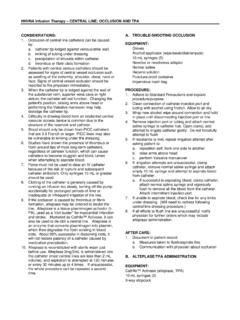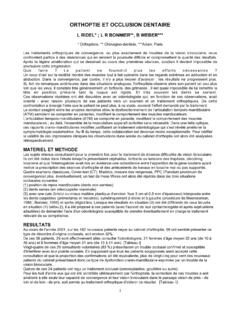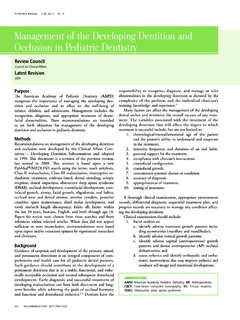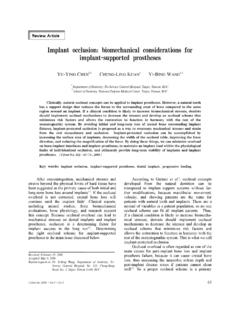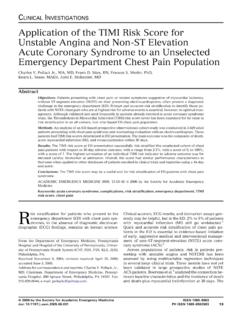Transcription of Trauma from occlusion - mv-endo.com
1 25 Vol. 26, No. 1 January 2004 Trauma from occlusion : a review Commander R. Dave Rupprecht, DC, USN Introduction occlusion and its relationship to periodontal disease has been and remains an area of considerable controversy. Over the years, there have been a number of human and animal studies investigating this relationship. The purpose of this Clinical Update is to summarize previous research, describe the signs and symptoms of Trauma from occlusion , and discuss treatment considerations. Definitions Before discussing Trauma from occlusion , a review of commonly used definitions will help facilitate understanding of this subject. Occlusal Trauma : An injury to the attachment apparatus as a result of excessive occlusal force (1). Occlusal Trauma is the tissue injury, and not the occlusal force.
2 Occlusal Trauma can be divided into 3 general categories: 1) Primary Occlusal Trauma : Injury resulting from excessive occlusal forces applied to a tooth or teeth with normal support (1). Examples include high restorations, bruxism, drifting or extrusion into edentulous spaces, and orthodontic movement. 2) Secondary Occlusal Trauma : Injury resulting from normal occlusal forces applied to a tooth or teeth with inadequate support (1). 3) Combined Occlusal Trauma : Injury from an excessive occlusal force on a diseased periodontium (2). In this case, there is gingival inflammation, some pocket formation, and the excessive occlusal forces are generally from parafunctional movements. Traumatogenic occlusion : Any occlusion that produces forces that cause an injury to the attachment apparatus (3).
3 Occlusal Traumatism: The overall process by which a traumatogenic occlusion produces injury in the periodontal attachment apparatus (3). Background As far back as 100 years ago, it was felt that occlusion played a significant part in periodontal disease (4) and the formation of vertical clefts (5,6). Glickman (7,8) proposed the Theory of Codestruction to explain the relationship between occlusion and periodontal disease. He described two regions in the periodontium: the zone of irritation (marginal and interdental gingiva and gingival and transeptal fibers) and the zone of codestruction (periodontal ligament, alveolar bone, cementum, transeptal and alveolar crest fibers). He felt that plaque induced gingival inflammation was confined to the zone of irritation.
4 Occlusal forces or traumatogenic occlusion effected the zone of codestruction but did not cause gingival inflammation. However, occlusal Trauma together with plaque induced inflammation acted as codestructive forces resulting in an alteration of the normal pathway of inflammation and the formation of angular bony defects and infrabony pockets. In contrast to the codestructive theory, Waerhaug (9,10) believed there was no proof that occlusal Trauma caused or acted as a cofactor in the formation of angular defects. He believed that infrabony pockets were associated with the advancing plaque front or apical growth of subgingival plaque and the formation of either horizontal or angular bone defects were dependent on the width of the interproximal bone. Teeth with narrow interproximal bone develop horizontal defects while teeth with wide interproximal bone were more likely to develop angular or vertical defects.
5 A number of animal studies using the Squirrel Monkey (11,12,13,14) and Beagle Dog (15,16,17,18,19,20) evaluated the effects of excessive jiggling forces in the presence of experimentally induced periodontitis. These two groups differed in some of their findings which may have been due to differences in study design and the animal model utilized. The conclusions of these studies are as follows: 1) Occlusal Trauma does not initiate gingival inflammation. 2) In the absence of inflammation, a traumatogenic occlusion will result in increased mobility, widened PDL, loss of crestal bone height and bone volume, but no attachment loss. 3) In the presence of gingival inflammation, excessive jiggling forces did not cause accelerated attachment loss in squirrel monkeys but increasing occlusal forces may accelerate attachment loss in beagle dogs.
6 4) Treating the gingival inflammation in the presence of continuing mobility or jiggling Trauma will result in decreased mobility and increased bone density, but no change in attachment level or alveolar bone level. Signs and Symptoms When evaluating a patient suspected of having occlusal Trauma there are a number of clinical and radiographic symptoms that may be present. These indicators of Trauma from occlusion may include one or more of the following (21,22): Clinical 1) Mobility (progressive) 2) Pain on chewing or percussion 3) Fremitus 4) Occlusal prematurities/discrepancies 5) Wear facets in the presence of other clinical indicators 6) Tooth migration 7) Chipped or fractured tooth (teeth) 8) Thermal sensitivity Radiographic 1) Widened PDL space 2) Bone loss (furcations; vertical; circumferential) 3) Root resorption Therapeutic goals and treatment considerations A goal of periodontal therapy in the treatment of occlusal traumatism should be to maintain the periodontium in comfort and function.
7 In order to achieve this goal a number of treatment considerations must be considered including one or more of the following (22): 1) Occlusal adjustment 2) Management of parafunctional habits 3) Temporary, provisional or long-term stabilization of mobile teeth with removable or fixed appliances 4) Orthodontic tooth movement 5) Occlusal reconstruction 6) Extraction of selected teeth Occlusal adjustment or selective grinding is defined as reshaping the occluding surfaces of teeth by grinding to create harmonious contact relationships between the upper and lower teeth (1). Just as controversy surrounds the subject of Trauma from occlusion and its role in the Clinical Update Naval Postgraduate Dental School National Naval Dental Center 8901 Wisconsin Ave Bethesda, Maryland 20889-5602 26 progression of periodontal disease, the same is also true regarding the subject of occlusal adjustment.
8 The 1989 World Workshop in Periodontics listed the following indications and contraindications for occlusal adjustment (23). Indications for Occlusal Adjustment 1) To reduce traumatic forces to teeth that exhibit: Increasing mobility or fremitus to encourage repair within the periodontal attachment apparatus. Discomfort during occlusal contact or function. 2) To achieve functional relationships and masticatory efficiency in conjunction with restorative treatment, orthodontic, orthognathic surgery or jaw Trauma when indicated. 3) As adjunctive therapy that may reduce the damage from parafunctional habits. 4) To reshape teeth contributing to soft tissue injury. 5) To adjust marginal ridge relationships and cusps that are contributing to food impaction. Contraindications for Occlusal Adjustment 1) Occlusal adjustment without careful pretreatment study, documentation, and patient education.
9 2) Prophylactic adjustment without evidence of the signs and symptoms of occlusal Trauma . 3) As the primary treatment of microbial-induced inflammatory periodontal disease. 4) Treatment of bruxism based on a patient history without evidence of damage, pathosis, or pain. 5) When the emotional state of the patient precludes a satisfactory result. 6) Instances of severe extrusion, mobility or malpositioning of teeth that would not respond to occlusal adjustment alone. A number of studies have reported that the presence of occlusal discrepancies is not associated with increased destruction caused by periodontal disease (24,25,26). Burgett (27) found that patients who received occlusal adjustment as a part of periodontal treatment had a statistically greater gain in attachment level than those who did not receive an occlusal adjustment.
10 While these results may have been statistically significant, these small differences did not have clinical significance. The 1996 World Workshop in Periodontics (3) found little recent research on the role of occlusion in periodontal disease. It also found no prospective controlled studies on the role of occlusion on untreated periodontal disease and that ethical considerations make it unacceptable to perform such studies. Recently, a pair of human studies found that teeth with initial occlusal discrepancies had significantly deeper initial probing depths, greater mobility and a worse prognosis than teeth without initial occlusal discrepancies. These studies also found that treatment of occlusal discrepancies significantly reduced the progression of periodontal disease and can be an important factor in the overall treatment of periodontal disease (28,29).
